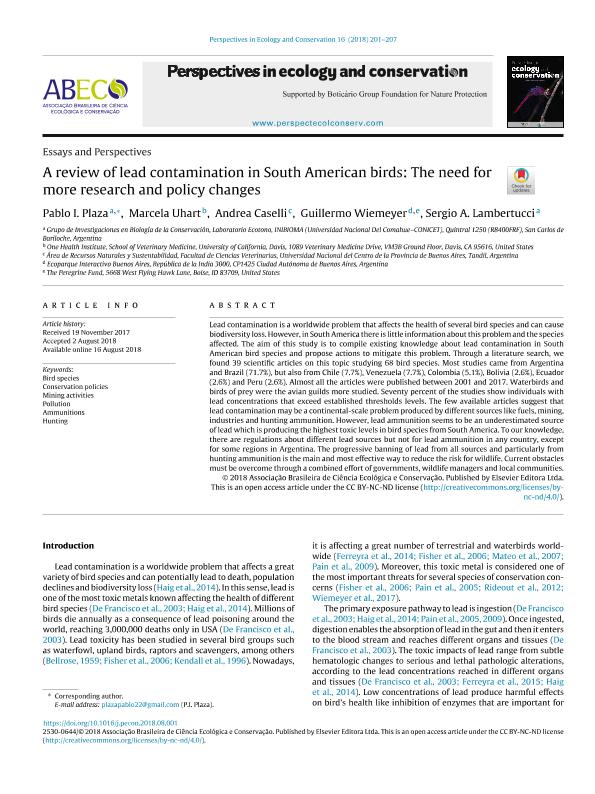Mostrar el registro sencillo del ítem
dc.contributor.author
Plaza, Pablo

dc.contributor.author
Uhart, Marcela María

dc.contributor.author
Caselli, Elsa Andrea

dc.contributor.author
Wiemeyer, Guillermo

dc.contributor.author
Lambertucci, Sergio Agustin

dc.date.available
2020-01-09T18:35:37Z
dc.date.issued
2018-10
dc.identifier.citation
Plaza, Pablo; Uhart, Marcela María; Caselli, Elsa Andrea; Wiemeyer, Guillermo; Lambertucci, Sergio Agustin; A review of lead contamination in South American birds: The need for more research and policy changes; Associação Brasileira de Ciência Ecológica e Conservação; Perspectives in Ecology and Conservation; 16; 4; 10-2018; 201-207
dc.identifier.issn
2530-0644
dc.identifier.uri
http://hdl.handle.net/11336/94165
dc.description.abstract
Lead contamination is a worldwide problem that affects the health of several bird species and can cause biodiversity loss. However, in South America there is little information about this problem and the species affected. The aim of this study is to compile existing knowledge about lead contamination in South American bird species and propose actions to mitigate this problem. Through a literature search, we found 39 scientific articles on this topic studying 68 bird species. Most studies came from Argentina and Brazil (71.7%), but also from Chile (7.7%), Venezuela (7.7%), Colombia (5.1%), Bolivia (2.6%), Ecuador (2.6%) and Peru (2.6%). Almost all the articles were published between 2001 and 2017. Waterbirds and birds of prey were the avian guilds more studied. Seventy percent of the studies show individuals with lead concentrations that exceed established thresholds levels. The few available articles suggest that lead contamination may be a continental-scale problem produced by different sources like fuels, mining, industries and hunting ammunition. However, lead ammunition seems to be an underestimated source of lead which is producing the highest toxic levels in bird species from South America. To our knowledge, there are regulations about different lead sources but not for lead ammunition in any country, except for some regions in Argentina. The progressive banning of lead from all sources and particularly from hunting ammunition is the main and most effective way to reduce the risk for wildlife. Current obstacles must be overcome through a combined effort of governments, wildlife managers and local communities.
dc.format
application/pdf
dc.language.iso
eng
dc.publisher
Associação Brasileira de Ciência Ecológica e Conservação
dc.rights
info:eu-repo/semantics/openAccess
dc.rights.uri
https://creativecommons.org/licenses/by-nc-nd/2.5/ar/
dc.subject
AMMUNITIONS
dc.subject
BIRD SPECIES
dc.subject
CONSERVATION POLICIES
dc.subject
HUNTING
dc.subject
MINING ACTIVITIES
dc.subject
POLLUTION
dc.subject.classification
Otras Ciencias de la Tierra y relacionadas con el Medio Ambiente

dc.subject.classification
Ciencias de la Tierra y relacionadas con el Medio Ambiente

dc.subject.classification
CIENCIAS NATURALES Y EXACTAS

dc.title
A review of lead contamination in South American birds: The need for more research and policy changes
dc.type
info:eu-repo/semantics/article
dc.type
info:ar-repo/semantics/artículo
dc.type
info:eu-repo/semantics/publishedVersion
dc.date.updated
2019-10-10T13:58:16Z
dc.journal.volume
16
dc.journal.number
4
dc.journal.pagination
201-207
dc.journal.pais
Brasil

dc.description.fil
Fil: Plaza, Pablo. Consejo Nacional de Investigaciones Científicas y Técnicas. Centro Científico Tecnológico Conicet - Patagonia Norte. Instituto de Investigaciones en Biodiversidad y Medioambiente. Universidad Nacional del Comahue. Centro Regional Universidad Bariloche. Instituto de Investigaciones en Biodiversidad y Medioambiente; Argentina. Universidad Nacional del Comahue. Centro Regional Universitario Bariloche. Laboratorio de Ecotono; Argentina
dc.description.fil
Fil: Uhart, Marcela María. University of California; Estados Unidos
dc.description.fil
Fil: Caselli, Elsa Andrea. Universidad Nacional del Centro de la Provincia de Buenos Aires. Facultad de Ciencias Veterinarias; Argentina
dc.description.fil
Fil: Wiemeyer, Guillermo. The Peregrine Fund; Estados Unidos. Ecoparque Interactivo Buenos Aires; Argentina
dc.description.fil
Fil: Lambertucci, Sergio Agustin. Universidad Nacional del Comahue. Centro Regional Universitario Bariloche. Laboratorio de Ecotono; Argentina. Consejo Nacional de Investigaciones Científicas y Técnicas. Centro Científico Tecnológico Conicet - Patagonia Norte. Instituto de Investigaciones en Biodiversidad y Medioambiente. Universidad Nacional del Comahue. Centro Regional Universidad Bariloche. Instituto de Investigaciones en Biodiversidad y Medioambiente; Argentina
dc.journal.title
Perspectives in Ecology and Conservation
dc.relation.alternativeid
info:eu-repo/semantics/altIdentifier/url/https://www.sciencedirect.com/science/article/pii/S2530064417302067
dc.relation.alternativeid
info:eu-repo/semantics/altIdentifier/doi/http://dx.doi.org/10.1016/j.pecon.2018.08.001
Archivos asociados
